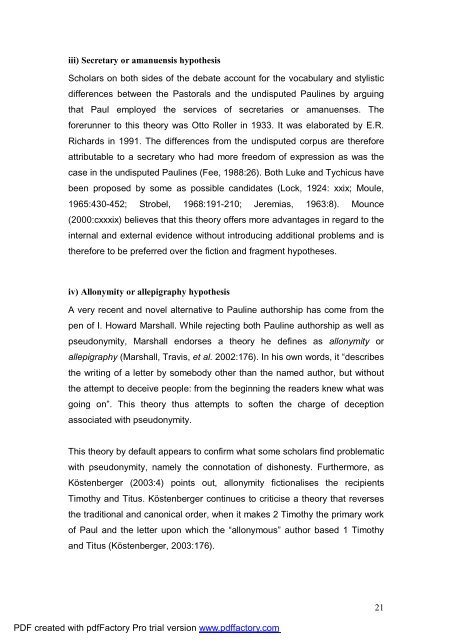A Text centred rhetorical analysis of Paul's Letter to Titus
A Text centred rhetorical analysis of Paul's Letter to Titus
A Text centred rhetorical analysis of Paul's Letter to Titus
You also want an ePaper? Increase the reach of your titles
YUMPU automatically turns print PDFs into web optimized ePapers that Google loves.
iii) Secretary or amanuensis hypothesis<br />
Scholars on both sides <strong>of</strong> the debate account for the vocabulary and stylistic<br />
differences between the Pas<strong>to</strong>rals and the undisputed Paulines by arguing<br />
that Paul employed the services <strong>of</strong> secretaries or amanuenses. The<br />
forerunner <strong>to</strong> this theory was Ot<strong>to</strong> Roller in 1933. It was elaborated by E.R.<br />
Richards in 1991. The differences from the undisputed corpus are therefore<br />
attributable <strong>to</strong> a secretary who had more freedom <strong>of</strong> expression as was the<br />
case in the undisputed Paulines (Fee, 1988:26). Both Luke and Tychicus have<br />
been proposed by some as possible candidates (Lock, 1924: xxix; Moule,<br />
1965:430-452; Strobel, 1968:191-210; Jeremias, 1963:8). Mounce<br />
(2000:cxxxix) believes that this theory <strong>of</strong>fers more advantages in regard <strong>to</strong> the<br />
internal and external evidence without introducing additional problems and is<br />
therefore <strong>to</strong> be preferred over the fiction and fragment hypotheses.<br />
iv) Allonymity or allepigraphy hypothesis<br />
A very recent and novel alternative <strong>to</strong> Pauline authorship has come from the<br />
pen <strong>of</strong> I. Howard Marshall. While rejecting both Pauline authorship as well as<br />
pseudonymity, Marshall endorses a theory he defines as allonymity or<br />
allepigraphy (Marshall, Travis, et al. 2002:176). In his own words, it “describes<br />
the writing <strong>of</strong> a letter by somebody other than the named author, but without<br />
the attempt <strong>to</strong> deceive people: from the beginning the readers knew what was<br />
going on”. This theory thus attempts <strong>to</strong> s<strong>of</strong>ten the charge <strong>of</strong> deception<br />
associated with pseudonymity.<br />
This theory by default appears <strong>to</strong> confirm what some scholars find problematic<br />
with pseudonymity, namely the connotation <strong>of</strong> dishonesty. Furthermore, as<br />
Köstenberger (2003:4) points out, allonymity fictionalises the recipients<br />
Timothy and <strong>Titus</strong>. Köstenberger continues <strong>to</strong> criticise a theory that reverses<br />
the traditional and canonical order, when it makes 2 Timothy the primary work<br />
<strong>of</strong> Paul and the letter upon which the “allonymous” author based 1 Timothy<br />
and <strong>Titus</strong> (Köstenberger, 2003:176).<br />
PDF created with pdfFac<strong>to</strong>ry Pro trial version www.pdffac<strong>to</strong>ry.com<br />
21

















